With the third season of Formula E now in the rear-view mirror, there’s plenty to talk about in regards to this young motorsport series.
We attended the final two races in Montreal and witnessed a surprising amount of engagement from the crowd while learning a lot about this new type of racing.
But first, let’s get up to speed: Formula E is an all-electric open-wheel racing series with 10 teams of two drivers vying for the championship. As of season three, each car packs a 28-kWh battery and each driver has a pair of cars, switching into a fully charged one midway through the race. Future seasons will see this element change and cars are expected to get bigger batteries that can last the whole race.
Here are a few other interesting things we learned while attending the races in Montreal.
Cooling Batteries is Really Important

A quick stroll through the pits where teams and mechanics work on the race cars exposed an interesting part of EV racing. While there are fewer oily bits and moving parts to worry about on a Formula E vehicle, one thing that is a constant concern is battery temperature. As a result, you’ll witness technicians shoveling ice into one of the pods on the side of the car, desperately trying to keep the battery cool. Some teams utilize very sci-fi looking liquid nitrogen to do the trick.
A representative from the Jaguar Panasonic Racing team explained that the cars will shut down if the temperatures rise above 60 degrees Celsius. Batteries get very warm very quickly when they’re being recharged — imagine how your phone feels hot after being charged — and that’s pretty much what happens when the regenerative brakes are used to recharge the battery. As a result, the team has to decide when to use the regenerative brakes or conventional brakes so they don’t overheat the battery.
FanBoost is Fun!

When the racers qualify, there’s no emphasis on battery conservation. As a result, the racecars use a tune where their electric motors have an output of 200 kW or roughly 270 horsepower.
However, in the race, the cars are tuned down to about 170 kW or 230 ponies. Where did that extra power go? It’s unlocked by the fans via a voting process called FanBoost. Three drivers are given the opportunity to boost their cars output a few minutes into the race, and will be allowed to utilize that extra power in their second car, during a particular period of the race.
It may sound gimmicky to give drivers an extra advantage, but it’s an interesting way to involve fans in this new racing series. It’s just enough power to initiate a pass or bring a racer closer to their competitors, but it isn’t an overwhelming boost that makes for a easy-breezy pass.
Teams Need a Battery Swap Strategy

As mentioned before, racers have to swap into another car halfway through the race, but there’s no defined time that they have to make that maneuver. The one rule is that the car change has to take at least 47 seconds.
Sometimes racers will choose to pit during a yellow flag so that they won’t lose position, while others try to stretch their battery for a few laps more while others are swapping. The regenerative brakes on demand also seem to help stretch the life of the battery as well.
Many Different Configurations Exist

An interesting aspect of Formula E is that the rules have changed a few times over the past few seasons. This is an attempt by the series to advance EV technologies and bring new tech to the forefront of the industry. In season one, almost everything was locked down. The cars all used a single electric motor that was mounted longitudinally, and a five speed gearbox. There were also specific manufacturers making the components, like McLaren with the motor, Hewland with the gearbox, and Williams Advanced Engineering handling the traction battery.
In season 2, the series opened up the development of the motor, gearbox, differential and casings. And finally, in the third season, things are tightened up a bit to stricter regulations, but still open to different designs and manufacturers. As a result, there are eight different powertrains in the series used among 10 teams. For example, the season three team champions, Renault e.Dams team, uses a transverse electric motor supplied by a company called Zytek. The racecar doesn’t even have a transmission, so the motor drives the differential directly via a reduction gear. The Techeetah racing team actually uses a customer supply of this setup.
Season three drivers champion Lucas Digrassi, from the ABT Schaeffler Audi Sport team, uses a racecar that features a longitudinal engine setup and a three-speed gearbox. Another team, NextEV, utilizes two motors and no gears.
Basically, there’s a lot of variation to the way the cars are designed and that helps to make the race more interesting.
A Quiet Race Means a Fan-Friendly Race

There’s a lot of noise from motorsport fans about how Formula E cars don’t sound like racecars. That’s very true, as the quick vehicles sprint around with no backfiring, loud exhausts, or any noises that’s typically associated with racing. Instead, these cars sound like a sci-fi sound effect (think a door opening in ) stretched over the span of an hour.
But as a result, that means the series can race in more fan friendly and convenient locations. The race can be held right in the heart of a city, so there’s no need for a long trip or camping plans just to catch competitive racing. It also means that it’s family friendly, too. Fans also don’t need to worry about damaging their ears.



Leave a Reply